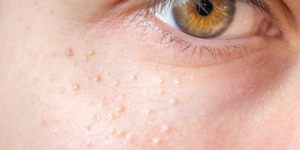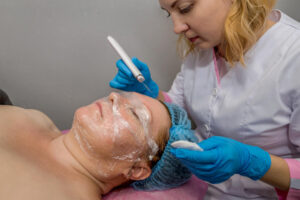This post contains affiliate links, and we will be compensated if you buy after clicking on our links
Show Contents
Hide Contents
 How to Get Rid of Milia
How to Get Rid of MiliaClearing the Way: How to Get Rid of Milia
Have you ever been frustrated with the unwanted bumps on your skin? Those pesky little bumps that don’t seem to go away no matter what you try? Well, there’s good news for those of us plagued by milia — yes, those bumps are called milia!
Thankfully, various treatments and home remedies are available to help clear them up, from oral antibiotics to exfoliating treatments, so you don’t need to worry about how to get rid of milia. This guide will show you how to get rid of milia for good. Read on!
What are Milia?
 Milia
MiliaMilia are tiny white bumps on the skin’s surface, usually around the eyes or cheeks. They are very common among adults and range from 1 to 4 millimeters.
They are caused by clogged pores that trap dead skin cells beneath the epidermis. These trapped cells then form cysts under the skin’s surface, leading to whitehead-like bumps.
What Causes Milia?
 Milia
MiliaMilia are typically caused by clogged pores that trap oil, sweat, and dirt beneath the skin’s surface. These blocked pores form small cysts under the epidermis, which then appear as white or yellow bumps on the skin.
Common causes of milia include sun damage, certain medications, allergies, trauma to the skin, and even genetic predisposition. Knowing what triggers your milia can help you prevent them from forming in the future.
Types of Milia
Primary Milia
 Primary milia
Primary miliaPrimary milia are small cysts that can be found on the eyelids, forehead, cheeks, or genitals. They are a common skin condition that affects both children and adults alike.
Although they can occur in both adults and children, primary milia are most common in newborns due to their immature skin composition.
Juvenile Milia
 Juvenile Milia
Juvenile MiliaJuvenile milia are cysts that are a result of an inherited condition. They may appear from birth or later in life and usually present as tiny, hard lesions on the face, neck, arms, and legs.
These may be linked to certain inherited genetic disorders, such as Basal Cell Naevus Syndrome, Rombo Syndrome, Pachyonychia Congenita, Gardner Syndrome, and Bazex Dupre Christol Syndrome.
Neonatal Milia
 Neonatal Milia
Neonatal MiliaNeonatal Milia is a condition that affects infants and causes white cysts to form on the baby’s skin. These cysts tend to appear in places like an infant’s nose, cheeks, or forehead, usually at or shortly after birth.
It’s essential to note that this type of milia is benign and harmless — no medical treatment is necessary. You can wait for it to disappear for 2-4 weeks.
Secondary Milia
 Secondary milia
Secondary miliaSecondary milia is a type of milia that occurs when an external source has damaged the skin. This can include blisters from poison ivy, burns, long-term use of steroid creams, and years of sun damage.
Additionally, using products that are too heavy for your skin type can also lead to this type of milia — which may be more challenging to treat than primary milia.
Multiple Eruptive Milia
 Multiple Eruptive Milia
Multiple Eruptive MiliaMultiple eruptive Milia is a rare condition that causes the formation of cyst clusters for weeks to months, typically on the face, upper arms, and upper abdomen. These cysts can be itchy and uncomfortable.
Milia en Plaque
 Milia en Plaque
Milia en PlaqueThis rare type of Milia predominantly affects women or people born as females between 40 and 60 years old. The milia will clump together on a raised patch of skin, commonly behind the ears, on the eyelid, cheek, or jaw.
Often, this type of milia happens to people with genetic skin conditions, such as lichen planus and discoid lupus, and an autoimmune condition.
Preventing Milia
Using sun protection
 A woman wearing a hat and applying sunscreen for a sun protection
A woman wearing a hat and applying sunscreen for a sun protectionSun protection is essential for preventing milia, especially secondary milia. You can use many things to protect your skin from sun exposure, especially harmful UV rays, such as hats, sunscreen, and UV-protective clothing.
Using these products properly can help to reduce your chances of developing milia and other signs of sun damage. Additionally, avoiding prolonged exposure to direct sunlight will further decrease your risk of developing this condition.
Cleansing and steaming
 A woman cleansing her face using face wash
A woman cleansing her face using face washSince one of the main causes of milia is clogged pores, cleansing your skin regularly using gentle face wash will help prevent milia from forming. In addition, taking your time to do steaming sessions is also encouraged, as it helps open up pores and moisturize your skin.
Treatment Options
 Chemical peels to treat milia
Chemical peels to treat miliaTretinoin or oral antibiotics
People with milia en plaque will most likely say consuming tretinoin or oral antibiotics to the how to get rid of milia question. These two treatments are proven to be effective in treating milia.
Tretinoin is an ointment medication that works by softening and breaking down the outer layer of the bumps to reduce their size or make them go away completely.
Also, oral antibiotics, like tetracycline or doxycycline, are used as treatments for milia. These medications work by killing bacteria that can cause inflammation and lead to milia formation, hence reducing inflammation and providing relief in the affected area.
Chemical peel
Gentle chemical peels can take care of milia by eliminating the outermost layer of skin. Doing so will reveal a new, even complexion.
Typically, the treatment uses a solution with glycolic acid or salicylic acid to scrape away the impacted skin area. For gentle peels, pain relief isn’t typically required, and you can expect stinging sensations that are only slight in intensity.
De-roofing
De-roofing is a type of treatment used to treat milia that involves cutting a tiny bit of the skin’s top layer and using a very small comedone extractor to push out the keratin plug, allowing the milia to be released and removed. This procedure is by far the simplest answer to the how to get rid of milia question.
Laser ablation
If you have multiple milia, your dermatologist will most likely advise you to undergo laser ablation to treat them. The process includes laser energy to break down the trapped keratin. Also, the laser energy encourages the keratin to be reabsorbed in the skin. However, people with dark skin are better off avoiding this treatment as it may cause discoloration.
Frequently Asked Questions
Are there any home remedies that can effectively remove milia?
Yes, there are several home remedies to remove milia, including using a warm compress, lemon juice, honey, tea tree oil, exfoliating cleanser, retinoid cream, milkweed extract, and essential oils.
Are there potential risks or side effects associated with milia removal?
Yes, there are some potential side effects and risks associated with milia removal. If not done properly, there is a risk of scarring, infection, or hyper-pigmentation.
Conclusion
In conclusion, milia is an annoying skin condition that can be challenging to eliminate. However, several methods exist to reduce and eliminate the presence of milia. Stubborn cases may require extra products or professional help, but in most cases, home remedies and lifestyle changes are effective.
Since many of these treatments involve exfoliation and irritation, it’s essential to be gentle with your skin; otherwise, you risk further inflammation and hyperpigmentation. Lastly, make sure always to cleanse your face, wear sun protection, and do proper skincare routines to prevent milia.
With the right knowledge and approach about how to get rid of milia, keeping those pesky white bumps at bay for good is possible!
Depending on the day, you’ll find Rebecca in a well thought-out ensemble that she handcrafted herself, or in hiking and rock climbing gear. An avid outdoorswoman, cyclist, and cat lover, Rebecca reminds us all on the Groom+Style team just how much we need to get outdoors. She’s worked in spas and salons off and on before going full-time with the G+S team. Linkedin: https://www.linkedin.com/in/rebecca-moses-3158b914b/
View all posts